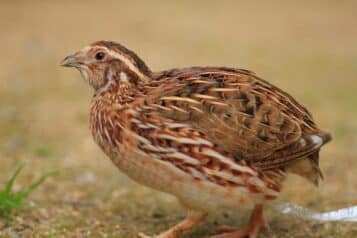Quail may seem like simple creatures, but there’s a whole world of diversity within this fascinating family of birds. Each type offers something unique, from the popular Coturnix and Bobwhite quail to the lesser-known King and Montezuma quail species. Whether you’re an avid bird watcher, a hunter, or someone interested in raising quail, understanding the different species can enrich your experience and knowledge.
Our comprehensive guide aims to introduce you to quail species, diving deep into their characteristics, habitats, and distinctive features. Let’s embark on a journey to explore the captivating realm of these remarkable birds.
Japanese Quail – A Quick Summary
Appearance
The Japanese quail is a small, plump bird with a short tail and a round body. It is typically 13-18 cm in length and weighs 100-160 g. The plumage is gray-brown with a white throat and a black patch on the head. Males are slightly larger and have a more pronounced black patch than females.
Habitat
Japanese quail are native to East Asia, but they have been introduced to many other parts of the world, including North America and Europe. They are typically found in grasslands, brushy fields, and open woods.
Diet
Japanese quail are omnivores and eat a variety of foods, including seeds, insects, and small fruits. They are also known to eat small invertebrates, such as slugs and worms.
Behavior
Japanese quail are social birds and live in groups of up to 50 individuals. They are active during the day and roost at night on the ground or in low vegetation.

Reproduction
Japanese quail breed from April to September. The female lays 6-12 eggs per clutch, and the incubation period is 17-18 days. The chicks are precocial and can leave the nest within a few hours of hatching.
Predators
Japanese quail are preyed upon by a variety of animals, including foxes, snakes, and hawks. They are also killed by vehicles and humans.
Conservation status
The Japanese quail is classified as Least Concern by the IUCN. However, populations in some areas are declining due to habitat loss and hunting.
Economic importance
Japanese quail are raised for their meat and eggs, which are considered to be a delicacy. They are also popular game birds.
In captivity
Japanese quail are easy to keep in captivity and make popular pets. They are relatively quiet birds and do not require a lot of space. They are also fairly hardy and can tolerate a variety of climates.
Check out one of our sister sites, Pheasant Donkey and Waterfowl Donkey!
